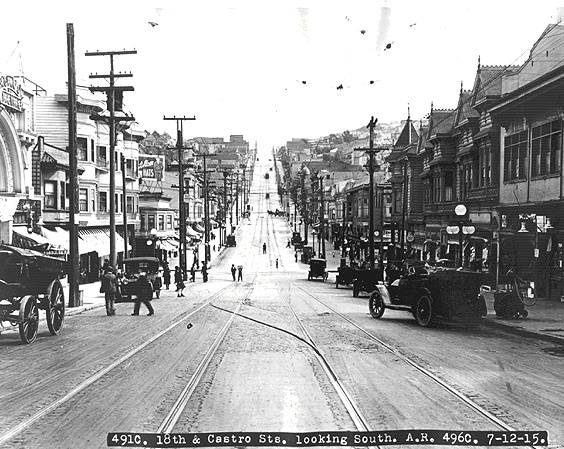Castro: Difference between revisions
Texteradmin (talk | contribs) No edit summary |
(Added neighborhood description) |
||
| (One intermediate revision by one other user not shown) | |||
| Line 5: | Line 5: | ||
'''18th and Castro looking south, July 12, 1915.''' | '''18th and Castro looking south, July 12, 1915.''' | ||
''Photo: | ''Photo: Private Collection, San Francisco, CA'' | ||
''Text partially excerpted from 'The District Handbook: A CORO Foundation Guide' | |||
Eureka Valley began as a quiet Victorian neighborhood made up of working class Germans, Scandinavians, and Irish. The original residents, the Ohlone Indians, roamed the grassy valleys until the Spaniards founded Mission Dolores close by. The Spaniards rounded up the Indians, brought them into the mission and sent Candelario Valencia, Francisco Guerrero, and Victor Castro to tend sheep and cattle in the Eureka and Noe valleys. | |||
The area did not experience any significant population changes until after World War II, when the Scandinavians, Irish, Germans, and Italians began to leave Eureka Valley for the suburbs. As a result, the economy of the area began to suffer and many businesses closed. The art deco Castro Theater was almost forced to shut its doors. | |||
In the early 1970s, the rapidly growing gay/lesbian population in the San Francisco area revitalized the neighborhood when they renovated old houses and rebuilt the commercial industry. | |||
The main commercial street within the neighborhood formerly referred to as Eureka Valley is Castro Street, which has led to the area more commonly being referred to as "The Castro." Harvey Milk Plaza, at the corner of Market and Castro, is named for San Francisco's first openly gay supervisor. Eureka Valley is made up of a widely varied population, but it is the character or Castro Street that has made it famous. | |||
Latest revision as of 16:03, 10 November 2014
18th and Castro looking south, July 12, 1915.
Photo: Private Collection, San Francisco, CA
Text partially excerpted from 'The District Handbook: A CORO Foundation Guide'
Eureka Valley began as a quiet Victorian neighborhood made up of working class Germans, Scandinavians, and Irish. The original residents, the Ohlone Indians, roamed the grassy valleys until the Spaniards founded Mission Dolores close by. The Spaniards rounded up the Indians, brought them into the mission and sent Candelario Valencia, Francisco Guerrero, and Victor Castro to tend sheep and cattle in the Eureka and Noe valleys.
The area did not experience any significant population changes until after World War II, when the Scandinavians, Irish, Germans, and Italians began to leave Eureka Valley for the suburbs. As a result, the economy of the area began to suffer and many businesses closed. The art deco Castro Theater was almost forced to shut its doors.
In the early 1970s, the rapidly growing gay/lesbian population in the San Francisco area revitalized the neighborhood when they renovated old houses and rebuilt the commercial industry.
The main commercial street within the neighborhood formerly referred to as Eureka Valley is Castro Street, which has led to the area more commonly being referred to as "The Castro." Harvey Milk Plaza, at the corner of Market and Castro, is named for San Francisco's first openly gay supervisor. Eureka Valley is made up of a widely varied population, but it is the character or Castro Street that has made it famous.
Pages in category "Castro"
The following 53 pages are in this category, out of 53 total.
C
- Cable Car - Castro 1939
- Neighborhood/Geography
- Castro and Market Over the Years
- Castro St North 1901
- Castro St South 1915
- Castro Street 1997
- Clayton-Market Switchback
- Coming Out into the 1970s
- Corbett and Clayton 1915
- Corbett Road
- Corona Heights
- Corwin Community Garden and Seward Mini-Park
- Corwin Park to Tank Hill
F
N
T
- The 1970s: Disco Fever and Respectability
- The 1980s
- THE BURNING OF THE OLD STATE BUILDING
- The Castro Into the 90s
- The Castro: The Rise of a Gay Community
- The Duboce Bikeway Mural: Gateway to the Wiggle
- The Gold Rush Financiers: Pioche and Robinson
- The Sisters of Perpetual Indulgence,Inc.
- Time-Travelling Wall
- Twin Peaks Tunnel

